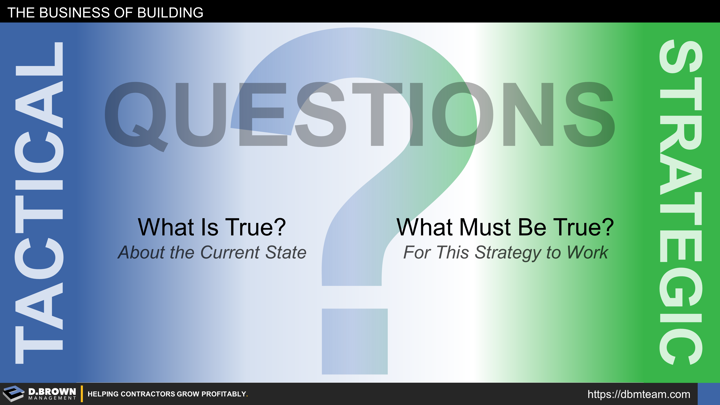TACTICAL: What is true about the current state?
This involves a myriad of internal factors, such as capabilities, capacity, and desire, along with a much broader range of external factors, including the market(s) you are currently in, the customers you currently work with, and the suppliers you use.
STRATEGIC: What must be true for this strategy to work?
Considering many of the same questions but from a future ideal state.
"Begin with the end in mind." - Stephen Covey
Start your planning exercise by setting objectives in the 3+ year timeframe, based on the strategic questions, without considering the current state (tactical). This will be very difficult for most managers in construction contracting because we are built for operations, where tactical questions and decisions rule the day.
For each of those items, take a very objective inventory of your current state, even if it is uncomfortable.
As an example–let's say you develop an "Ideal Customer Profile" for your target future state. You review current customers that make up 80% of your business against this profile and realize that none of them fit. Making matters worse, you believe you are doing business with all of the customers in this market sector.
This is where the hard work begins, just like on a project. Use a process similar to pull-planning, placing your future-state objectives (what must be true) on the right side of the whiteboard and your current state (what is true) on the left. Divide the whiteboard into years.
Start laying out small steps, working both backward and forward.
You will likely lay out several paths. For instance:
- Training, managing, and leading select current customers to become closer to your ideal customer profile.
- Searching for new customers who better fit your profile and may want to enter this particular market sector.
- Looking at different market sectors where customers are closer to your ideal customer profile.
In this particular situation, we've seen all three of these paths work and we've seen all three come up short. Making strategic decisions is about placing your bets with the highest probability of winning based on the risk being taken. It is not about guaranteeing success.
Work through each path independently, constantly backing up and evaluating the probability of success.
Your final plan may involve taking one path, multiple concurrent paths, or choosing a totally different direction.
You will be surprised at the progress you can make with consistent effort. For example, while it may seem very difficult in the present when you are trying to pay your bills, having just 3 to 5 "Ideal Customers" can form the foundation that can make a contractor–at any stage of growth–incredibly successful. Your plan may involve taking two years for each customer to get your foot in the door and prove yourself.
"Most people overestimate what they can achieve in a year and underestimate what they can achieve in ten years." - Bill Gates
This is an area where an experienced and unbiased third party can be extremely valuable to stretch the team without overstretching them.
All relationships begin with a simple conversation. Let's schedule time to talk.

